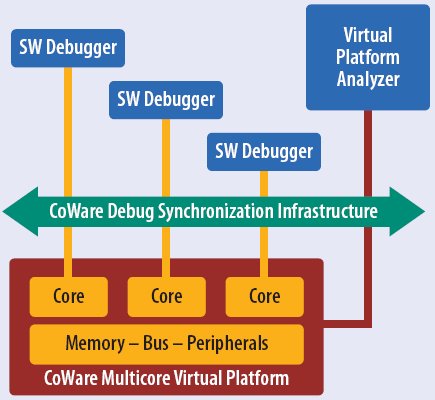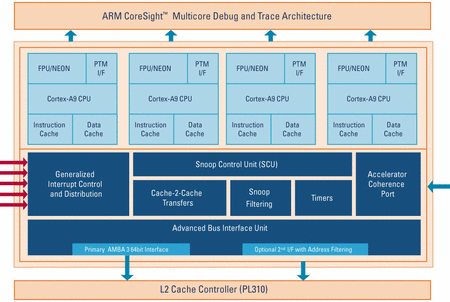Virtual platform used to prep Cortex-A9 design
Jul 22, 2009 — by Eric Brown — from the LinuxDevices Archive — 5 viewsSemiconductor manufacturer NXP has deployed a development platform based on CoWare's Virtual Platform ESL technology, designed to port Linux to Cortex-A9 processor-based designs in advance of their physical availability. NXP's Virtual Prototyping Environment (VPE) integrates ARM's “Fast Models” for ARM Cortex, suggesting that NXP will soon join TI in announcing a Cortex-A9 SoC.
Last year, NXP switched its SystemC-derived VPE to a platform based on CoWare's Virtual Platform and then deployed it company-wide, says CoWare, which is promoting the VPE/ARM Cortex-A9 project as a design win. The solution helped NXP achieve significant time and cost savings in software development and validation compared to traditional emulation-based methods, claims the company.
NXP's VPE is an internal development environment that helps developers work with virtualized representations of electronic systems, says CoWare. With VPE, developers can use cost-effective debugging and analysis features without requiring hardware prototypes or development test benches, claims the company.
For NXP's ARM Cortex-A9 project, it integrated the ARM Cortex-A9 Fast Model, and was able to port Linux to the processor "in record time, ahead of RTL availability," says CoWare.
VPE features are said to include:
- Enhanced debug visibility combining CoWare Virtual Platform Analyzer with a software debugger
- Reproducibility and predictability through full scripting environment
- High-speed simulation performance for Cortex-A9 subsystem
- Ease of deployment across multiple globally separated engineering sites
Netherlands-based NXP makes SoCs (system-on-chips) and reference designs for portable media players (PMPs), TVs, set-top boxes (STBs), identification applications, and automotive infotainment systems. Last year, the company spun off its wireless group in a joint venture with STM to form ST-NXP Wireless. In February of this year, NXP announced a broad licensing deal with ARM that included access to the Cortex-A9.
CoWare Virtual Platform
CoWare's electronic system-level (ESL) Virtual Platform offers ARM processor models and Carbonized ARM models within a SystemC design environment, says the company. Virtual Platform is said to enable software engineers to exploit the capabilities of ARM system elements including memory controllers, interconnects, application and embedded processors, and embedded firmware, "in the context of the actual design."

Multi-core debugging with CoWare's Virtual Platform
CoWare, which counts ARM and Cadence among its investors, offers a variety of Linux-ready ESL tools, services, and virtual platforms under the "ESL" moniker. In February, the company released ESL 2.0, claiming compatibility with Google's Android mobile device platform. In October of last year, CoWare and MontaVista Software announced they were shipping a jointly developed version of Virtual Platform that runs MontaVista Linux and offers MontaVista's Eclipse-based DevRocket integrated development environment (IDE).
Cortex-A9 ready to roll
Announced in 2007, the Cortex-A9 core technology has taken its sweet time coming to market, yet the first Cortex-A9-based silicon should start sampling by the end of the year, or early 2010, according to recent statements by ARM. Like ARM Ltd.'s popular 65nm-fabricated Cortex-A8 core, which is used in the Texas Instruments (TI) OMAP3x, as well as the Freescale i.MX51x, and in modified form (instruction set only), in the Qualcomm Snapdragon SoCs, the multi-core enabled Cortex-A9 uses superscalar technology.
The superscalar pipeline can execute multiple instructions simultaneously, to deliver "more than 2.0 DMIPS per MHz," according to ARM. This helps it provide a similar power envelop and silicon cost to ARM11, while delivering far greater more performance. Yet while Cortex-A8 is touted as being three times faster than ARM11, Cortex-A9 is claimed by ARM to offer "four to 16 times more" performance.

Cortex-A9 block diagram
(Click to enlarge)
In February of this year, TI announced OMAP4x, a next-generation SoC due to sample later this year that is built around a dual-core version of Cortex-A9. It now appears that NXP may be another Cortex-A9 customer, and Freescale and Qualcomm may also yet be heard from on this subject before long.
Stated Barry Dennington, SVP, CIT Design and Flows, NXP Semiconductors, "The cooperation between ARM and CoWare to enable VPEs for software development on Cortex processor-based designs made it possible for us to significantly save on the software development and validation effort."
Stated John Cornish, EVP and GM, of ARM, System Design Division, "In a close collaboration with CoWare, we have been able to combine the value of the Virtual Platform technology and Fast Models enabling NXP to distribute fast, trusted, and reliable virtual prototypes for software development."
Stated Marc Serughetti, VP, Marketing and Business Development, CoWare, "The tight partnership between CoWare and ARM, through the integration of the Fast Models for the ARM Cortex processors in CoWare Virtual Platform combined with expert support, has provided NXP with quantifiable results showing the benefits of electronic system virtualization."
Availability
Neither CoWare or NXP offered further information on the availability of Cortex-A9-based designs.
This article was originally published on LinuxDevices.com and has been donated to the open source community by QuinStreet Inc. Please visit LinuxToday.com for up-to-date news and articles about Linux and open source.